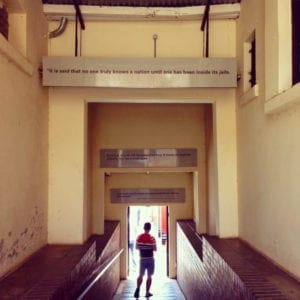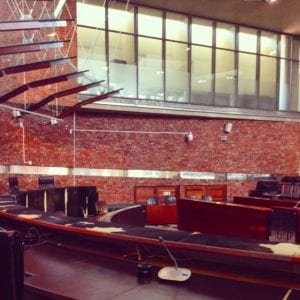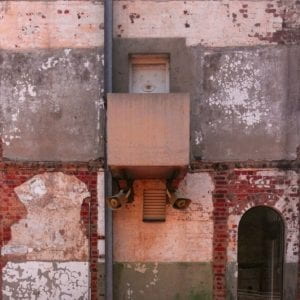By Laura McTighe
This is the second in a series of articles that Laura McTighe will be writing for The Revealer over the next year about issues at the intersection of race and religion. She will be writing about incarceration, activism and organizing, reproductive justice, and more, with an eye to questions of history, violence, and justice.

“It is said that no one truly knows a nation until one has been inside its jails. A nation should not be judged by how it treats its highest citizens, but its lowest ones – and South Africa treated its imprisoned African citizens like animals.” -Nelson Mandela (Photo by Laura McTighe)
“That’s because you live in the United States of Amnesia!” my friend chided as we descended into the bowels of Johannesburg’s notorious Number Four prison. “Indeed,” I laughed in agreement. Back home, I was far more accustomed to the “it wasn’t that bad” approach to our nation’s past, as if whitewashing our collective histories of violence would make them go away. For more than a century, the “Moonlight and Magnolias” myth of life in the antebellum South has dominated our national consciousness. Only one plantation in the United States – Louisiana’s Whitney Plantation – tells the story of slavery from the perspective of the enslaved, and it only just opened on December 8, 2014 after a long, embittered struggle led by local Black residents. Entering Number Four, I was unable to contain my shock at how meticulously the curators of this prison-turned-museum had documented the perversions of apartheid justice perpetrated within the carceral complex.
Number Four is a relic of apartheid governance: even in their confinement, people classified as native, coloured and Asian had to be kept separate from whites. In its heyday, Number Four held some of the most notable leaders of the liberation struggle. But the vast majority of those confined were the hordes of Black people arrested every day under the Pass Laws that controlled their movement in and out of the townships to which they had been forcibly relocated. Today, the hallowed walls and recesses of Number Four are filled with the oral and written testimonies of former political prisoners, creating a painful, if imperfect, archive of life inside.
Ekhulukhuthu (the deep hole) isolation cells extended along the furthest-most wall of Number Four. Each concrete box is fixed in time, stripped of bedding with only a small beam of natural light filtering through the peep hole guards used to spy on those confined. Now, only one cell door remains bolted shut. When I turned to my friend for explanation, his finger was already outstretched: “That cell is haunted.” I nodded slowly, as my gaze refocused on the closed isolation cell door: “I think this whole place is haunted.”
* * *
What do we do with our collective histories of violence?
It is a question that the entire complex now known as Constitution Hill is actively engaged in making sense of. Not only has Number Four been meticulously preserved and filled with testimonies of the abuses perpetrated therein; the trio of prisons it is a part of (the whites-only Old Fort, the non-white Number Four and the panoptic Women’s Gaol) serve as a sort of courtyard for the new South African Constitutional Court. The relationship between the past and the present here, however, is not merely one of proximity. The walls of the Constitutional Court are constructed entirely out of bricks from the demolished awaiting-trial cells that used to stand on the site.
There are many questions we could ask about why the designers of the Constitutional Court chose to “upcycle” the materials that enclosed thousands of South Africans arrested for no more than what we in the United States would call “walking while Black.” It seems more important, now, though, to reflect on the effects of that choice.
In religious studies we think a lot about the creation and protection of boundaries. How is the sacred delineated from the profane? How are they kept apart? What would happen if they were to mix? A tremendous amount of everyday ritual activity is dedicated to preserving boundaries, to ensuring that matter never falls out of place. As such, these boundaries not only teach us about what matters to communities; they also help us to understand what they are afraid of.
Back in the United States of Amnesia, we work hard to hermetically seal our histories of violence, thereby creating an impenetrable boundary between the past and the present. Constitution Hill’s flagrant disregard for this boundary was striking, if a bit disquieting. Bringing the bricks that had once muffled the cries of the detained into the new nation’s court was a powerful act. The space groaned.
And it also rejoiced. Outside the court, two awaiting-trial cells had been left standing. Their painted interior walls lay exposed. Large speakers adorned their unseemly facades, humming the melodies of struggle songs. It was as if the voices of those awaiting trial had demolished the cells themselves – brick by brick, wall by wall.
* * *
Inside Number Four, the groans that filled the Constitutional Court became recognizable as the voices of Molefe Makiti, political prisoner, 1963; Molefe Pheto, political prisoner 1975; Alex La Guma, political prisoner, 1956; Indres Naidoo, political prisoner, 1963; Henry Nxumalo, pass offender, 1954; Samuel Nthute, political prisoner, 1963; Prema Naidoo, political prisoner, 1982; and Godfrey Moloi, prisoner, 1956. Their oral histories recorded the horrors of life inside Number Four, starting with the meal area.
Apartheid law regulated prison meal rations by race, with gram per day allowances for rice, meat, fish, beans, vegetables, fat, sugar and salt. In practice, meals generally consisted of rotten boiled fish, which was served on trays as dirty as the pads and blankets that passed for prison bedding. The perimeter of the meal area was lined with stretches of “toilets” where guards would taunt political prisoners as they feebly tried to aim at holes in the ground and defecate the slime that passed for food.
The most ceremonious debasement came when the incarcerated returned from court appearances: the guards forced them to strip naked and undergo the infamous tauza “dance” in the prison courtyard as part of a rectal cavity search.
The perimeter of the courtyard was lined with group cells, each holding a different trace of the everyday violence of apartheid justice: soiled bedding, torture devices, broken games…
When I walked into the final group cell, I jumped back in shock at the sight of a perfectly positioned tank, constructed entirely out of prison-issued blankets. It was a piece of visionary fiction, to use Octavia’s Brood’s phrase: what was imagined had been brought to life. Those held captive at Number Four dared to envision a world that did not exist. They took on the might of the apartheid state armed only with woolen cloth and twine. And they won.
What do we do with our collective histories of violence?
Constitution Hill forces us to reckon with the fact that our histories of violence are not really past. Put differently, the point is not whether we are haunted (as if not being haunted is some sort of proof that we have officially overcome); the point is whether we are willing to be haunted.
* * *
In 1940, shortly after his release from a French prison camp, Walter Benjamin famously penned, “The only writer of history with the gift of setting alight the sparks of hope in the past, is the one who is convinced of this: that not even the dead will be safe from the enemy, if he is victorious. And this enemy has not ceased to be victorious.” In late November of 2014, Rinaldo Walcott breathed new life into this imperative, asking about the physical, emotional and spiritual labor of defending the dead, of convincing the world that #BlackLivesMatter.
Constitution Hill inflects this sense of obligation somewhat differently: How do we live with the dead?
Being haunted might sound creepy, even scary. What ghosts might we encounter if we open ourselves to their presence? But perhaps in our haunting – in our willingness to be haunted – we might begin to understand why our collective histories of violence have such power to press upon our presents. And in so doing we might also begin to imagine new ways of moving forward… As Saidiya Hartman reminds us in her memoir of a journey along the Atlantic slave route, Lose Your Mother: “If the ghost of slavery still haunts our present, it is because we are still looking for an exit from the prison.
***
All photographs by Laura McTighe.
***
Laura McTighe is a Ph.D. Candidate in the Department of Religion at Columbia University. Through her dissertation project, “Born In Flames,” she is working with leading Black feminist organizations in Louisiana to explore how reckoning with the richness of southern Black women’s intellectual and organizing traditions will help us to understand (and do) American religious history differently. Laura comes to her doctoral studies through more than seventeen years of direct work to challenge the punitive climate of criminalization in the United States and support communities’ everyday practices of transformation. Currently, she serves on the boards of Women With A Vision, Inc. in New Orleans, Men & Women In Prison Ministries in Chicago and Reconstruction Inc. in Philadelphia. Laura’s writings have been published in Beyond Walls and Cages: Bridging Immigrant Justice and Anti-Prison Organizing in the United States (2012), the International Journal for Law and Psychiatry (2011), Islam and AIDS: Between Scorn, Pity and Justice (2009), and a variety of community publications.






